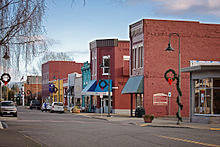Why did the town of Buckley have a much larger population than Enumclaw in the late 19th century?
If you lived in Enumclaw and needed a doctor, you had to cross the White River in a rowboat attached to a cable that spanned the water to the southern shore. There were no physicians in Enumclaw. Why did Buckley once have more residents and why did it change?
There are several explanations that can give us insight into economics.
According to authors Steve Meitzler and Nancy Irene Hall of “Buckley 1892,” here’s the story: “In 1892 Buckley was a town on the edge of the frontier…. It is on the borderline between the magnificent timber on the western slope of the Cascade Mountains and the rich body of agricultural lands that slope from these mountains to Puget Sound.” Being only a half-mile south of the White River there was “abundant waterpower and excellent facilities for logging and floating timber.” There were also two active coal mines within 2.5 miles. (Remember, the White River would not be tamed by the Mud Mountain Dam until 1948.)
The Northern Pacific built a line from Tacoma through the Orting Valley and up to the mining camp at Wilkeson and on to Buckley in 1885. If you take the Rails-to-Trails path south from Buckley, you are following its route down to Tacoma. Eventually, a trestle was built across the White River which traveled through Enumclaw and over the Naches Pass to points east. A wagon bridge made of steel from San Francisco and wood from Buckley was constructed across the White River, ending the boat ferry in September 1891.
Buckley was incorporated in 1890 with a rapidly growing population of nearly 1.000. By 1891 there was one sawmill, a shingle mill and a sash and door factory. There were two more shingle mills two miles away. Additionally, there were three large general merchandise stores, four saloons, a boot and shoe store, a tailor shop, a paint shop, two millinery stores, two barber shops, a jewelry store, a stationery store, a bazaar and two drug stores; also two blacksmiths, one carpenter shop, a bank and a large hotel. This was Buckley 23 years before Enumclaw, its neighbor to the north, was incorporated (1913).
For the lumber and shingle mills, old-growth timber was all around, with many trees within the city limits. There were 150 wood products workers laboring in the mills. Transport costs were low. Each day the mills produced 50,000 feet of lumber and 250,000 shingles. Each week 100 railroad cars were filled with wood-manufactured goods.
Two physicians and three lawyers hung out their shingles (manufactured in Buckley) and 260 students attended the White River School District.
On May 5, 1892, a fire turned most of downtown Buckley into ashes. There was another business center fire in 1898 that again destroyed much of the downtown. Today, as a result, much of downtown Buckley is made of brick, also produced in Buckley.
Why, then did Enumclaw grow large, relatively speaking, while Buckley diminished? The population of Enumclaw in the 1940s was only about 2,500 people. Today, Buckley’s population is about 5,300 while Enumclaw’s is 13,000.
The completion of Mud Mountain Dam in 1948 meant the loss of construction jobs for Buckley and Enumclaw residents. In 1944, the Buckley Logging Company mill closed, ending railroad logging, causing the loss of timber jobs. (In contrast, the Weyerhaeuser mill above Enumclaw remained open until late 2002 or early 2003.) In 1947, the last company-operated coal mining company closed (Pierce County Library Buckley Branch via Wikipedia.org). In 1959 the N.P. railroad terminal was torn down. Since that time, the rails have been torn up and turned into a hiking/biking path.
Part of the answer lies in the building of Rainier School in 1932. By 1958 there were 1,918 clients at the institution for the developmentally disabled. Today, there are around 310. Many Buckley residents work at the school which was incorporated into the city limits in 1947. Mutual of Enumclaw, founded in 1898, is still one of Enumclaw’s largest employers.
Why is Enumclaw now larger than Buckley? Three hypotheses arise from conversations with local historians: 1) Enumclaw had more diversity of farming, thus encouraging more settlement. The Danes who immigrated to Enumclaw, for example, encouraged their relatives in Europe and in the U.S. to join them. 2) Logging and mining died out in Buckley and Wilkeson sooner. Enumclaw had little mining, so its population was not affected by mine closings. 3) The two fires in 1892 and 1898 stunted Buckley’s growth at a crucial time in the city’s development.
Since that time, Buckley has become a bedroom community for commuters to Tacoma and King County. It will soon have its first Starbucks, and many new homes are being built in the city. Is it possible that Buckley will once again become larger than Enumclaw? Black Diamond and Maple Valley’s rapid growth may provide an answer.


